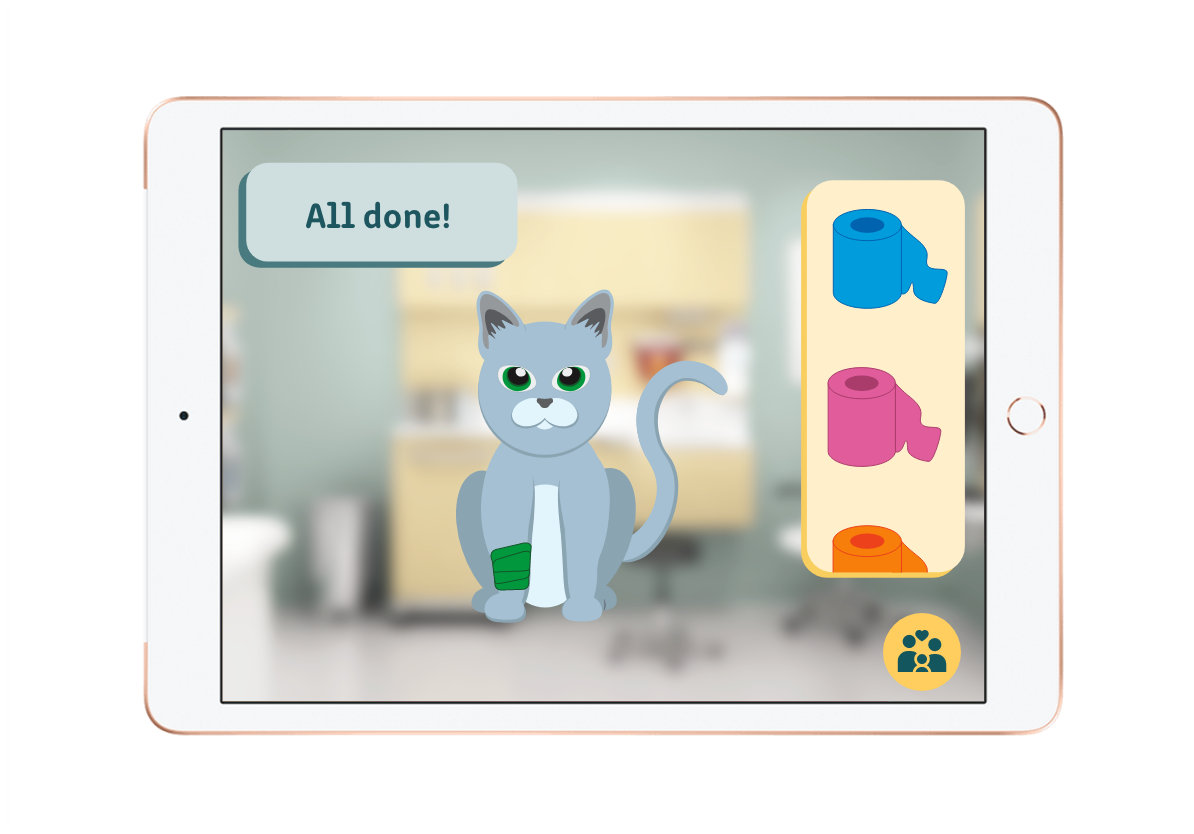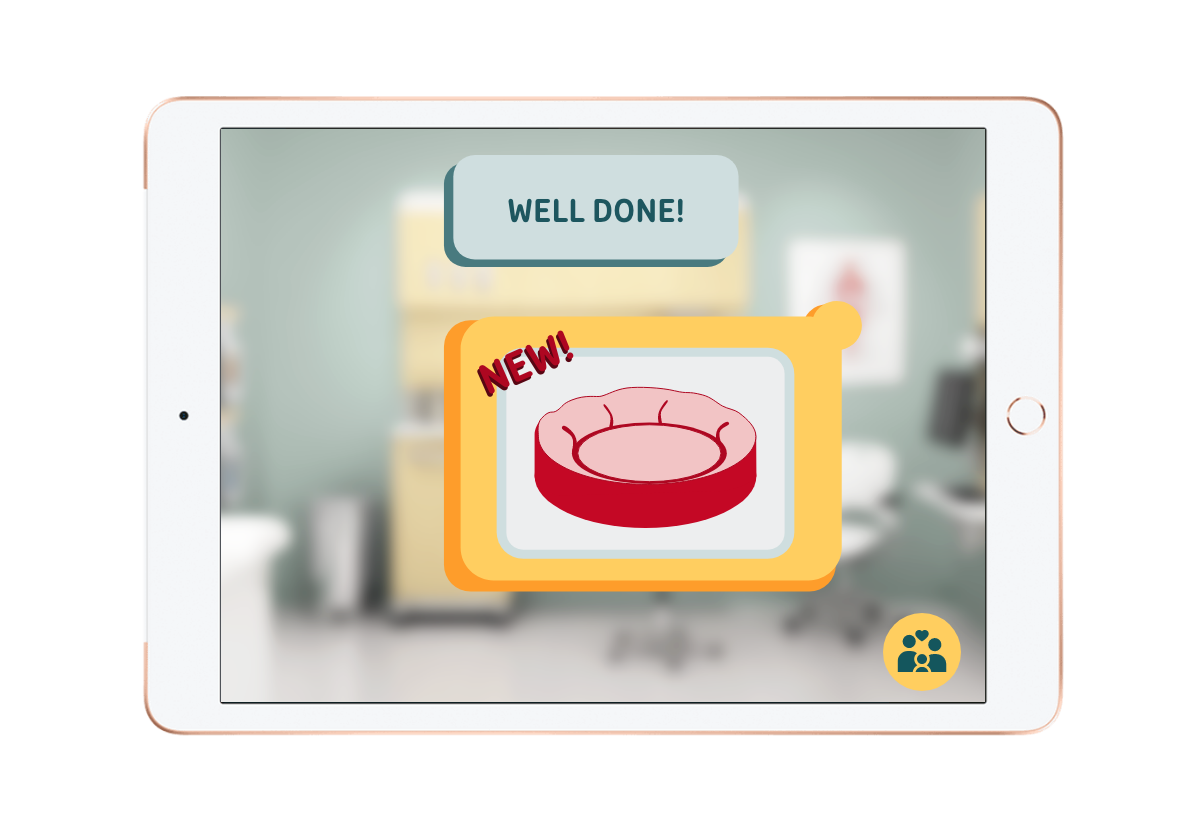Dr. Tot
Dr. Tot is an application created for children ages 3 to 6 to use during or before their doctor’s appointment during their pediatric visit. Parents can also use the companion app to help their child virtually experience the different stages of the healthcare visit by guiding and monitoring their screen activity. This project was a culmination of my thesis dissertation at the Iowa State University for my Graphic Design Master of Arts program.
Why?
This project was inspired by my two-year-old son, Anthony. I clearly remember the anxiety I experienced as a first time mother, when taking him to the doctors office. I thought about how I didn’t want my son to feel this way once he began to understand that he was in a new and unfamiliar environment.
Research [1] shows that when children are put into an environment where they feel a lack of control, they are at risk of psychological trauma. That can result in anxiety, anger or aggression.
This application is designed to assist parents and help children to virtually experience, and thus better understand, the various medical; processes that they may be subjected to during their upcoming visit.
The research goal for this project is to first understand pediatric health care and the concerns associated to a health care visit, especially for children between the ages 3 to 6.
It will consider case studies to identify the role of pediatricians in a health care setting and take into consideration the challenges faced by children and parents during a health care visit.
This information will then be finally used for recommending an intuitive solution involving the design of an AR-based mobile application for both children and parents to use prior, during and after a health care visit.
[1] Source goes here
Initial Sketches
The Child (Primary) Application
Paper prototyping began with concept sketching in order to conceptualize and visualize the idea of having both a parent and child side to the application.
The idea behind having a dedicated child application was for the child to have the access to to play games and learn about health care visits.
While in the application the child would press play on their tablet and the screen would zoom into the hospital lobby with patients inside. While the nurse takes the child back, the child is send a video explaining why these medical procedures must be done. After the end of the video, there would be a reward system put in place to encourage child to finish video and game.
The Parent (Companion) Application
On the parent’s application, they are first taken to the application’s home page. The home page houses the primary features of the application.
Includes: Parent Control, Doctor Review, Past Appointments, New Appointments, Pharmacy, and Settings
These features offer the parent multiple functionalities that helps them in controlling and curating:
the child (primary) application,
the pediatric appointments,
the AR games of the application, and
the videos and games to be sent to their child.
Low Fidelity
Low fidelity wireframes were developed in Adobe XD (Experience Design), a vector-based experience design platform.
Child low fidelity wireframe of Login Screen.
Child low fidelity wireframe of Sign Up.
Child low fidelity wireframe screen of Dr. Tot children home screen.
Child low fidelity wireframe screen of Dr. Tot hospital game screen.
Child low fidelity wireframe screen of hospital game lobby.
Child low fidelity wireframe screen of patient being treated.
Child low fidelity wireframe screen showing the game being paused by the parent.
Child low fidelity wireframe screen that displays a welcome message and silhouette of character.
Child low fidelity wireframe screen showing pop up message with gift/reward.
Child low fidelity wireframe screen showing encouraging screen of completion of game.
Parent low fidelity screen of Login screen.
Parent low fidelity screen of Home screen.
Parent low fidelity screen of children's profiles.
Parent low fidelity screen of Child's Profile page.
Parent low fidelity screen of Parent Control page.
Parent low fidelity screen of During Appointment page.
Parent low fidelity screen of Post Appointment page.
Parent low fidelity screen of New Appointment page.
Parent low fidelity screen of Upcoming Appointment page.
Parent low fidelity screen of Doctor Review page.
Parent low fidelity screen of Doctor's Summary page.
Parent low fidelity screen of Pharmacy page.
Parent low fidelity screen of Parent Notes page.
Asset Creation
For the creation of this applications assets, Adobe Illustrator was utilized. The assets were created as vector illustrations, which were then used in Adobe XD for application prototyping.
Final Application Design
Parent/Companion Application
In order to understand the application for the child we need to understand the companion application that aimed to be used by parents. The features available on the companion application enable parents to set up their child/children’s primary tablet application and curate their experience.
Account created by parent will let them have access to all additional features of both applications.
Enter phone number to enter code to reset password.
Parent is able to create multiple child profiles for families with more than one child.
Home screen consists of Child Profile, Parental Control, Appointments, Pharmacy and Settings.
Can add their relevant information to the system and also assign a tablet device to this account.
These three sections of the application can be used by the parents to control the app flow on their children's devices prior, during and post a pediatric appointment.
In the Pre-Appointment section, parents are able to customize their child's content on the tablet before their appointment. Included on this page is the "Submit Questions" button where parents can directly share their questions with pediatric staff to better prepare for an upcoming visit.
Parents can queue different instructional and demonstration videos for their children to see to better understand upcoming medical procedure during visit. The parents are also able to control when videos are accessible during pediatric visit.
This section allows the parent to push further instructional videos to their child after the appointment.
Parents can access Review, Notes and Summary in this section.
Parents may leave a review of the pediatric doctor/surgeon.
Add important notes related to that appointment for future reference.
Access the "Summary" shared by the pediatric doctor/surgeon at the end of the visit.
Appointment feature lets parents control their child's appointments.
Parents can schedule a new appointment using their smartphone’s calendar that can be linked to a third-party work calendar (Google/Outlook Calendar).
Parents can reschedule existing appointments directly from within the application. Dr. Tot will then relay the same information to the pediatric center and complete the appointment rescheduling without the need of an in-person visit, cellular call or an electronic mail.
Previous/ Past appointments can be accessed as a list, letting parents gain quick access to the previous appointment summaries, reports, comments, notes and more.
The "Pharmacy" gives parents the access to their child's prescription information as provided by the pediatric doctor/surgeon.This section also houses all the children's profiles.
Child/Primary Application
Unlike the parent/companion application that is meant to be used on a smartphone, the primary Dr. Tot application is designed to be used by children on a bigger tablet screen. Once the parent has used the companion application to set up the virtual environment for the child/children using the available instruction videos, activities, tasks and instructions, children can start using the primary application on their end on their tablet devices.
After the parent logs in, the child may choose to play games or to explore and learn more about healthcare environments.
Hit play and goes to Hospital lobby.
Message appears, greeting the doctor (the child).
Child is in need of medical care. The child may try out different medical equipment to help the crying child feel better.
Message appears, that all bandaids have been placed.
Bandaids are placed on the patient.
Screen gives an example on what appears on the child's tablet when the parent pauses from their device.
After bandaids, the child uses a thermometer to check the sick child's temperature.
After thermometer, the child taps on the icepack to cool down the patient.
The patient now feels all better.
Patient is better and child may move on to the next patient.
Press play to begin the augmented reality part of the application.
Child is able to chose their virtual companion. Choices are a dog, cat, panda and penguin.
Panda has been chosen.
AR game teaching children how to use a weighing scale at a pediatric center.
Child taps on the scale.
Message appears.
The child's companion receives treats as a reward for successfully completing game/task.
Inside the doctors office the child goes through their checkup with their virtual companion.
Message appears.
Video has been sent to the child's device explaining what the doctor will do next.
This video informs the child about vaccinations.
Message appears after video.
Companion goes first to demonstrate to the child what will happen.
Companion changes expression to show that the vaccine is unpleasant.
Then the panda changes expression again to depict that it only hurts a short while.
Message appears.
Cat demonstrating the X-Ray process.
Child is able to choose the cat's cast color.
At the end of the appointment the child receives a new item that can be stored in his Dr. Tot account.
Example of a video that can be watched post appointment to inform child about how their body will heal.
Additional Formats for Dr. Tot Application
Given that about 15% of children in the United States do not have access to technology devices like smartphones and tablet computers, it would impact their ability to access an application like Dr. Tot to familiarize themselves with a pediatric center prior to their visit. For such demographics, this study proposes the following: a coloring book, online streaming and DVD discs.




































































































